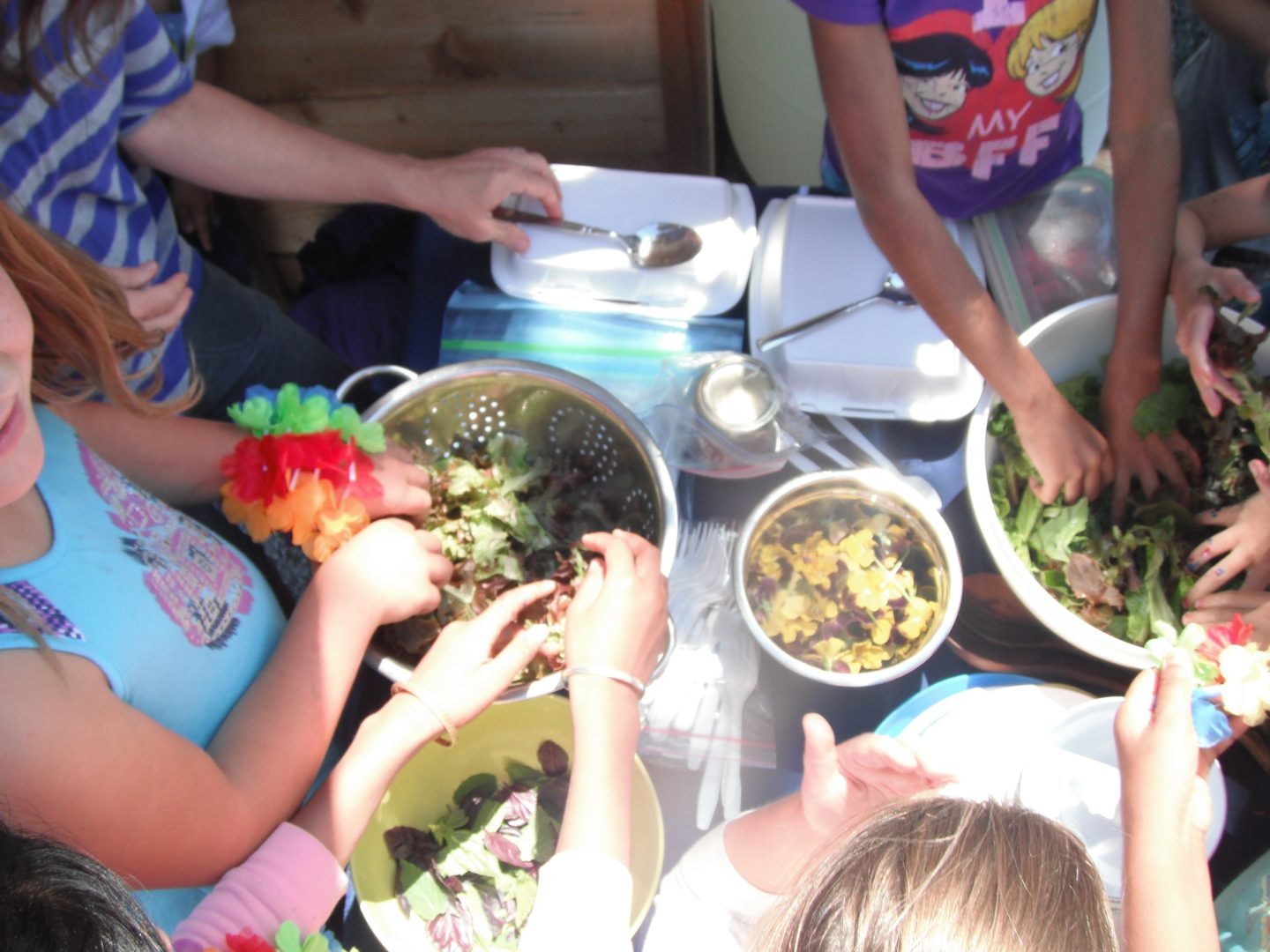Our Little/Big Idea
We wanted to create a garden at Yarrow Community School. The idea was to help students and families know the importance (and the joys!) of eating and growing fresh, local, organic food, for their health, and the health of the planet. We wanted our garden to be an inviting, accessible growing space near the school playground, where kids would be able to visit both on their own, and with their classes—and families outside of school hours—for garden learning adventures.
Successes: What We’ve Accomplished
With the help of Farm to School, parents, teachers, staff, other community members, and students themselves, we built seven large and two smaller raised beds, strawberry gutters, an ‘outdoor classroom’ gathering space with large stumps for seating near our garden shed, which has a chalkboard and clipboards for bringing learning outdoors. We’ve started Smoothie Tuesdays (see more below) and we also recently created a planter with a Plexiglas front, perfect for kids to peek “underground” at root veggies growing.
How do students engage? Some highlights: Planting. Watering. Harvesting a plethora of greens, veggies, herbs, edible flowers, and berries. Free-range garden snacking. They engaged with their classes during math, science, language arts. Garden art. Writing Poetry in the Garden with a local poet. Salad events. “Stone soup” story reading and soup-making. Seed saving. Germination experiments. School-wide composting, (compost and worm study). Gleaning field trip to a local farm, and donating the 500+ pounds of healthy produce to the local Food Bank.
Classes grew seedlings and decorated seed bags they donated to a community garden that serves low income folks. Our English language learners use the garden for living vocab, and students with special learning needs are empowered by special garden responsibilities.
Smoothie Tuesdays
Each week a different class blends up smoothies using our Smoothie Cycle (‘blender bike’) as well as our electric blender. They then deliver samples to the entire school (approx. 340 people) including staff, the preschool, and daycare, asking “Guess what’s in it? Guess which healthy ingredients were grown right here in Chilliwack? Which are from our own garden?” And then, they share their recipe.
Challenges, and How We’ve Faced Them
Our biggest challenge has been fear; fear of doing it “wrong,” fear of things not turning out as planned, fear of vandalism, fear of what people will say when the garden looks less like manicured landscaping, and more like a downright jungle—(as nature itself, and good food gardens often do).
We decided early on—and need to keep reminding ourselves—that if we take on the garden as a learning resource, and we keep engaging, there is no “wrong” way to do it. We trusted our kids. We’ve had no vandalism. We helped set expectations with kids and parents: that we were growing to learn about how things grow—and how they don’t. (When things don’t thrive, we can investigate “why?”) We spread the word that the intention is a true kids’ garden—rows (if any) would not be straight, and weeds are welcome if they’re edible or help attract pollinators.
We learned to stake out our space better—putting signs up of what’s planted where, to demark spaces, and to enhance communication with school district groundskeepers, so garden plants won’t get accidentally weed whacked (again—oops!).

How is Farm to School Making a Difference?
Farm to School not only helped us with the funding, (a good part of the garden build plus the equipment we use ongoing—our fridge, freezer, blender, and blender bike all were made possible by this grant), but they also provided us with a very helpful structure to turn our big idea into concrete steps towards making it happen.
Farm to School is the movement we’ve joined. It is what connects our program to so many others across the province and beyond. Farm to School is the resource that kept us from reinventing the wheel—and helped us set a solid foundation to grow on. Their annual events are a source of deep inspiration and a great coming together of like-minded folks working towards food literacy and the sustainability of our local food sources—and sharing that passion with children.
In Short:
In starting our garden, we wanted a way to help us better connect to:
- our food,
- our health,
- our environment, and to
- our community.
So far, in little ways, our garden is living up to our hopes in each of these aspects. And in a big way, we have Farm to School to thank.




